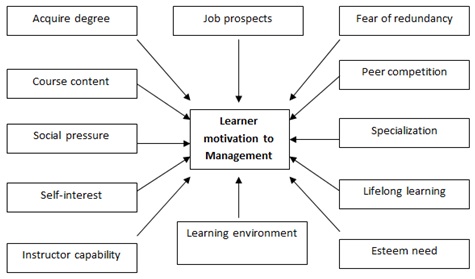The Goals, Structures, and Student Motivation: An Active Learning Approach
DOI:
https://doi.org/10.54741/mjar.3.4.4Keywords:
learning, management, scope, structures, modules, institutionsAbstract
Since India gained its independence, the necessity for management education has become increasingly apparent, and the number of educational institutions offering management education has skyrocketed. In fact, the knowledge substance of the curriculum becomes less significant in the postmodern model of higher education, where knowledge is frequently out of date before it can be employed (Kinman et al., 2007), compared to the significance of motivation to study management and the capacity to always stay current. Due to the modern business environment, internationalization of management education is another alternative that has been taken into consideration. A lot of work is now being done in relation to the depth, scope, and delivery of modules.
Downloads
References
Condry, J. (1977). Enemies of exploration: self-initiated versus other-initiated learning, Personality & Social Psychology, 35(7), 459-77.
Ames, C. (1992). Classrooms: Goals, structures, and student motivation. Journal of Educational Psychology, 84(3), 261-71.
Amabile, T.M., Hill, K.G., Hennessey, B.A., & Tighe, E.M. (1994). The work preference inventory: Assessing intrinsic and extrinsic motivational orientations. Journal of Personality and Social Psychology, 66(5), 950-67.
France, L., & Beaty, L. (1998). Layers of motivation: Individual orientations and contextual influences. Motivating Students. Birmingham: SEDA Publications.
Covington, M.V. (2000). Goal theory, motivation and school achievement: An integrative review. Annual Review of Psychology, 51, 171-200.
Covington, M.V., & Mueller, K.J. (2001). Intrinsic versus extrinsic motivation: An approach/avoidance reformulation”, Educational Psychology Review, 13(2), 157-76.
Clinton O. Longenecker, & Sonny S. Ariss. (2002). Creating competitive advantage through effective management education. Journal of Management Development, 21(9), 640 – 654.
Dupeyrat, C., & Marine, C. (2005). Implicit of intelligence, goal orientation, cognitive engagement, and achievement: A test of Dweck’s model with returning to school adults. Contemporary Educational Psychology, 30, 43-59.
Sprague, M., Lambert, L., Berry, T., & Siochi, A. (2006). Computer Games as a Learning Motivator. Information Technology and Teacher Education International Conference, Orlando, Florida, USA.
Chiu, C-M., Sun, S-Y., & Ju, T.L. (2007). An empirical analysis of the antecedents of web-based learning continuance. Computers and Education, 49(4), 1224-45.
Kang, B., & Tan, S. (2008). Impact of Digital Games on Intrinsic and Extrinsic Motivation, Achievement, and Satisfaction. Information Technology and Teacher Education International Conference, Las Vegas, Nevada, USA.
Dahl, D. W., & Smimou, K. (2011). Does motivation matter?: On the relationship between perceived quality of teaching and students' motivational orientations. Managerial Finance, 37(7), 582-609.

Downloads
Published
How to Cite
Issue
Section
License
Copyright (c) 2023 Srinivas Iyer, Pawan Kumbley

This work is licensed under a Creative Commons Attribution 4.0 International License.
Research Articles in 'Management Journal for Advanced Research' are Open Access articles published under the Creative Commons CC BY License Creative Commons Attribution 4.0 International License http://creativecommons.org/licenses/by/4.0/. This license allows you to share – copy and redistribute the material in any medium or format. Adapt – remix, transform, and build upon the material for any purpose, even commercially.









